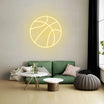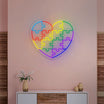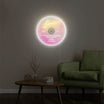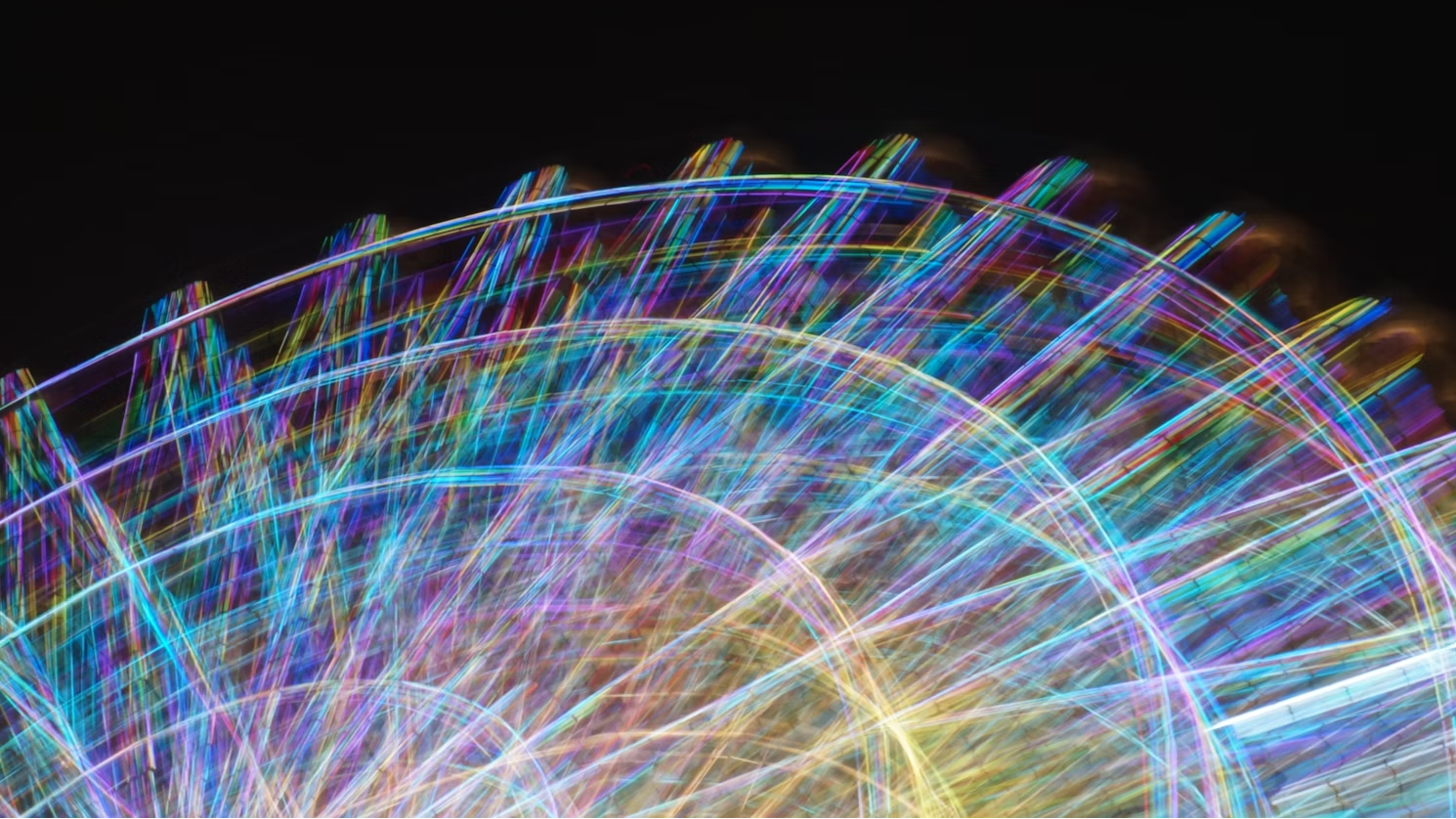Table of Contents
Neon acrylic artwork has become one of the most popular forms of contemporary art in recent years, thanks mainly to the power of acrylic and ease of customization. Neon acrylic lighting is bold, eye-catching, and futuristic, so it is often found decorating modern spaces in office buildings, malls, and homes.
In this guide, we discuss neon acrylic lighting in detail starting from the basics to more detailed and interesting facts you need to know. The guide covers various aspects of neon acrylic lighting such as definition, popular uses, and ways you can incorporate them in your spaces. You’ll get answers to all possible questions you might have about neon acrylic artwork here so let’s get right into it!

What Is Neon Acrylic Artwork
Neon acrylic artwork is a modern art form that combines acrylic materials with bright neon-like colors to create beautifully and visually striking décor. Neon acrylic artwork has been around for a while.
It is believed to have emerged in the mid-20th century when neon lighting was quite popular Artland. In its infancy, artists were using acrylic to create art that also mimicked the glowing effect of neon lights.
Neon acrylic artwork has changed over time and improved by leaps and bounds. Today. Neon art blends LED technology and modern design to create interactive and visually striking visual effects. The following are the main features of neon acrylic art:
Uses Acrylic as a Medium
From the name, neon acrylic art is mainly made using acrylic which has proved to be a durable and versatile material for many applications. Neon acrylic art uses lightweight and shatter-resistant acrylic sheets that can be found in a myriad of varieties to expand the artists’ range of creativity. Acrylic allows neon artists to play with light and layering of colors in ways not possible on many mediums.
Vibrant Colors and Designs
Neon acrylic art uses bold fluorescent colors mimicking the characteristic glow of traditional neon lights. The main aim when creating neon acrylic art is to depict an exciting and vibrant visual appeal in specific lighting conditions like. The best way to take advantage of this feature of neon art is to use it as a focal point in your space because it is so dramatic and striking to look at.
Illumination Techniques
Neon artwork is unique because it uses lighting (LEDs) or reflection to create and amplify a glowing effect. Artists have different approaches to how they use illumination techniques to create eye-catching interactions between their neon artwork and the environment they are mounted or placed. For instance, some use he effect to create an immersive and futuristic effect in dimly lit environments.
How Neon Acrylic Artwork Is Created
Because neon acrylic artwork is so customizable and acrylic so versatile, many artists have a personal routine or approach to creating their artwork. That said, in every approach or neon acrylic art project, you will find the following steps, albeit in different orders or formats:
1. Conceptualizing the Neon Artwork
The creation of a neon art piece must start with some basic conceptualization. Here the artist brainstorms ideas and makes different sketches of the art on paper or in electronic format using a tablet. Some considerations an artist might include in the concept include things like color, size, theme, lighting effects, and the purpose of the neon acrylic art piece. The aim is to balance the visual elements of the art piece with the materials in use which mainly include acrylic and pigments.
2. Choosing and gathering needed materials
Most artists will want to have all the materials they need to complete a neon acrylic artwork after they have completed the concept. The selection of materials and gathering involves choosing acrylic sheets based on factors like transparency, thickness, and color. For the best quality art, many artists prefer laser-cuttable acrylic as it allows for precision.
Other materials an artist needs to include in their kit include fluorescent or neon pigments and LED lighting components if they are required in their design. Both are used to create and amplify the characteristic glowing effect in neon artwork.
3. Cutting and Shaping Materials
The main initial work done when creating neon artwork is to cut and shape the materials. This mainly involves cutting, bending, and shaping the acrylic sheets into shapes using a laser cutter or a CNC machine of available. The latter is more expensive but preferred for creating intricate designs in bulk for commercial neon acrylic art projects. Both tools allow the artists to create clean edges and detail the art piece precisely which is necessary for modern neon acrylic art.
4. Engraving and Edging
Engraving and edging are two optional steps and can be used where needed. Here the artist engraves and etches the design into the base material which is acrylic with a laser or a rotary tool of their choice. The primary goal at this stage is to enhance the ability of the surfaces to refract light and glow. The etched patterns and designs will look sharp under illumination if this process is done to perfection.
5. Printing or Painting the Artwork
The artist can choose to paint or print the acrylic surface of the finished art with fluorescent ink or paint. Painting can be done using an airbrush or a normal brush while printing is normally done using UV printing technology. To save on money and get their neon art pieces done quickly main artists choose to use a third-party neon acrylic artwork UV printing service.
6. Integrating the Neon Light
The next step in this process involves adding lighting elements if they are part of the design. The artist can choose to add LED light strips inside or behind the acrylic base for added illumination and interactivity (for smart LEDs). They do this by arranging the LEDs and wiring them to a power source according to their design concept and testing it.
7. Assembling Layering the Neon Acrylic Art Piece
If the artist was working on a multi-dimensional neon acrylic art piece, they would need to stack and align the layers of acrylic base to build depth. They can use adhesives or spacers to secure the layers while keeping the entire assembly clean. This process makes the finished piece look more interesting and well-crafted.
8. Finishing Touches and installation
Lastly, the neon acrylic artwork will now be ready for mounting or installation but first, the artist will do some finishing touches. The finishing touches involved polishing the edges and surfaces, cleaning any residues, and removing scratches. They may also apply a protective coating to enhance the art piece’s durability. The last step in this process involves inspecting the piece in various lighting environments to ensure it appears as desired.
Installation or mounting is done once the acrylic art piece is ready and delivered to its intended location. These art pieces can be mounted with studs, hung with a string, or placed on a stand. Illuminated neon acrylic artwork should ideally be mounted where the lighting enhances its glow.

Popular Uses of Neon Acrylic Artwork
Neon acrylic is quite popular as a form of décor and a way to generate visual interest in many settings such as:
Even design: Event planners use neon acrylic artwork in parties, weddings, exhibitions, and more to create an ambient and visually interesting environment. They can also serve as unique backdrops or themed accents for visual appeal.
Art Installations: Neon acrylic artwork is commonly featured in art galleries and art-elated installations. They can be used to represent a nostalgic, futuristic, or dynamic theme.
Commercial Signage: Neon artwork is popular in commercial settings where it is used to create eye-catching signage for commercial entities like malls, businesses, etc. Neon acrylic artwork stands out, especially at night and it’s favored for branding and advertising campaigns because of this.
Interior Décor: Neon acrylic artwork features heavily in modern interior décor in homes and offices. It is used to add a modern touch to interior spaces and to create visually interesting focal points.
Benefits of Neon Acrylic Artwork
Neon acrylic artwork has many benefits including:
Neon Acrylic Art is Known for Durability
Neon acrylic artwork uses tough and durable materials (acrylic) which can last many years with minimal maintenance. This is why is loved in commercial settings for advertising purposes.
Customizability and Personalization
Artists using this medium have so much freedom to create art to fit any occasion, setting, or requirement because acrylic is so customizable. They can even create intricate engraved designs to match branding needs for commercial settings or printed designs for one-off events. It’s by far the most customizable art form in the market right now.
Modern and Minimalist
Neon acrylic art has evolved over the years to adopt a more modern and minimalist look that has kept up with modern trends. Today’s artists mainly focus on creating perfect geometric patterns and clean lights to create modern-looking neon art.
Neon art is sleek and futuristic. It is great for decorating modern commercial and living spaces. Being minimalist also makes it blend with the rest of the décor without being too overwhelming.
In Conclusion
In this guide, we discussed neon acrylic artwork in detail covering every aspect including features, benefits, applications, and how it is used. Neon acrylic artwork is a unique but surprisingly popular artwork that you may be interacting with daily without realizing it.
And the best thing is you can easily create your own online and have it delivered to your location using a company like Lamomoneon. Get stunning custom neon signs with Lamomoneon today and see the power of neon acrylic artwork in action.





















